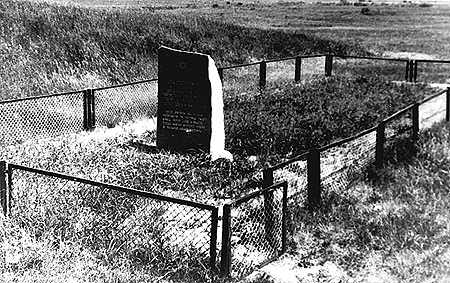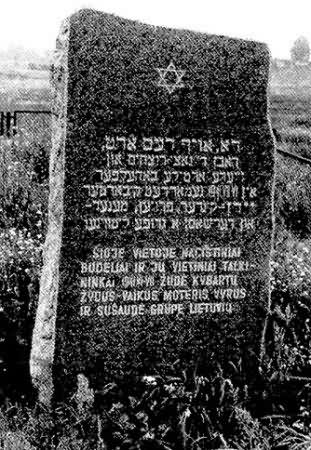
|
The German Occupation and the Destruction of the Jewish Community.
On June 22, 1941, between 4-5 o'clock in the morning, the German army entered Kibart' without any real resistance. Only a group of soldiers from the Russian Border Guard fortified themselves in the cellar of the mayor's building and fought to the last man.
The Germans freed all prisoners from jail, among them those accused of resistance to Soviet rule. They immediately started to organize local groups in order to take revenge on the communists and the Jews and also to help the Germans impose order and rehabilitate civilian life. The head of the Lithuanian activists who put themselves under German control was the veterinarian Zubrickas, who had arrived in Kibart in 1933, had been active in the Lithuanian nationalist organizations, as a result of which the Soviets had imprisoned him.
During the first days of occupation the German army ruled and did not take any measures against Jews. There were even cases of German authorities helping Jews to get back some property previously robbed by Lithuanians, with Jewish girls serving as interpreters in Eydtkuhnen
But after several days the Civil Administration was established and one of its first orders was to limit the rights of the Jews. The spokesman of the municipality passed through the streets and with the help of a bell assembled the crowd to read them this order:
- Jews are dismissed from their jobs in the municipality and in all other public and economic institutions.
- Jews are forbidden to leave the town or to move to another place without a permit. Jews have to deliver up all weapons and radios in their possessions.
- Jews are forbidden to leave their homes between 6 o'clock in the evening until 6 o'clock in the morning.
- It is forbidden for Jews to have any contact with non Jews.
- Jews have to prepare yellow patches to be worn on the back and on the front of their garment (at first it was a round patch, later it was changed to a "Magen David").
The first victims among the Jews were communists who had held positions in local institutions. Great anger was vented on those who had participated in the arrests the Soviet authorities had carried out just before the war. Among the first to be shot was the author's friend from high school Elhanan Halperin, who was a member of the Comsomol.
According to this method, which was, as became clear later on, identical everywhere, all the intelligentsia were detained first and transferred to the Gestapo in Eydtkuhnen. It became known, that when the lawyer Jehoshua Lurie was detained and transferred to Eydtkuhnen, his wife with their little blond daughter came to the commander of the S.S. and asked him to release her father. He was freed indeed but only for a short time, because a few days later he was murdered together with all the Jewish men of Kibart.
Kibart was situated in a strip 25 kilometers wide from the border with Germany, where Stahlecker had ordered the Gestapo of Tilzit to exterminate all Jews. The head of the Gestapo in Tilzit, Hans Joachim Boehme, contacted the Gestapo and the Border Guard in Eydtkuhnen in order to determine the date and all other details for the murder of the men in Kibart. The execution of this murder was to be an example for the Gestapo man from Eydtkuhnen, Tietz, who was in charge there and who was nominated to execute such murders in the future. (Tietz committed suicide later). The Lithuanian police too was informed about the date of the "operation." Their part was to detain the men, to assemble them and to act as guards, conveyors and executors.
At the beginning of July all Jewish men and youngsters above 16 were taken from their homes and concentrated in a barn in the farm of Baldamas in the village Gudkaimis, about 6 kilometers north of Kibart. There they were ill treated, left without food and water for several days and forced to dig holes in the nearby sand quarry of Peskynes.
During the night of Sunday, July 6, 1941, all were shot at the edge of the pits they had been order to dug, after having been forced to hand over all their belongings and to take off their upper clothing . 185 Jews and 15 Lithuanians, activists under previous Soviet rule, were shot that night. A monument in memory of the victims was erected at the mass graves several years ago.


The tombstone on the mass graves near Kibart with the inscriptions in Yiddish and Lithuanian:
"In this place were murdered by the Nazis and their local helpers the Jews of Kibart and a group of Lithuanians."
Among the victims there were the author's father and cousins Arye and Elyakim Leibovitz
|
JewishGen, Inc. makes no representations regarding the accuracy of
the translation. The reader may wish to refer to the original material
for verification.
JewishGen is not responsible for inaccuracies or omissions in the original work and cannot rewrite or edit the text to correct inaccuracies and/or omissions.
Our mission is to produce a translation of the original work and we cannot verify the accuracy of statements or alter facts cited.
 Kibart (Kybartai), Lithuania
Kibart (Kybartai), Lithuania
 Yizkor Book Project
Yizkor Book Project
 JewishGen Home Page
JewishGen Home Page
Copyright © 1999-2026 by JewishGen, Inc.
Updated 13 Mar 2003 by LA